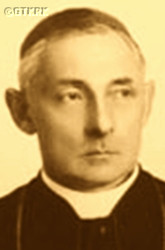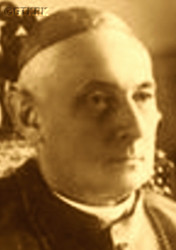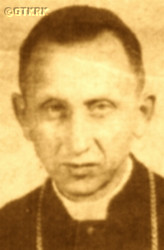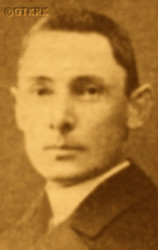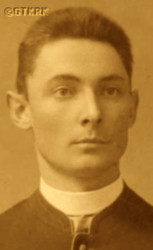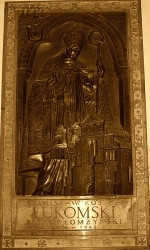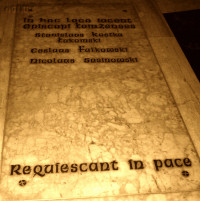Roman Catholic
St Sigismund parish
05-507 Słomczyn
85 Wiślana Str.
Konstancin deanery
Warsaw archdiocese, Poland
full list:
displayClick to display full list

searchClick to search full list by categories
wyświetlKliknij by wyświetlić pełną listę po polsku

szukajKliknij by przeszukać listę wg kategorii po polsku

Martyrology of the clergy — Poland
XX century (1914 – 1989)
personal data
surname
ŁUKOMSKI
forename(s)
Stanislav Kostka Andrew (pl. Stanisław Kostka Andrzej)
function
bishop
creed
Latin (Roman Catholic) Church RCmore on
en.wikipedia.org
[access: 2014.09.21]
diocese / province
Łomża diocesemore on
www.kuria.lomza.pl
[access: 2012.11.23]
Gniezno and Poznań archdiocese (aeque principaliter)more on
www.archpoznan.pl
[access: 2012.11.23]
honorary titles
Papal super–numerary private honorary chamberlainmore on
en.wikisource.org
[access: 2020.12.11]
(c. 11.11.1902)
Minor Canonmore on
en.wikipedia.org
[access: 2014.11.14]
(1916 – , St Peter and St Paul the Apostles RC archcathedral church, Poznańtoday: Poznań city pov., Greater Poland voiv., Poland
more on
en.wikipedia.org
[access: 2021.07.18])
„Polonia Restituta” Cross — 3rd Class, Commander'smore on
en.wikipedia.org
[access: 2019.04.16]
(29.12.1921)
National Order of the Legion of Honour (Fr. Ordre national de la Légion d'honneur)more on
en.wikipedia.org
[access: 2022.02.04]
Doctor Honoris Causa
(19.10.1926, Poznańtoday: Poznań city pov., Greater Poland voiv., Poland
more on
en.wikipedia.org
[access: 2021.07.18]; Poznań University UP)
date and place
of death
28.10.1948

Warsawtoday: Warsaw city pov., Masovia voiv., Poland
more on
en.wikipedia.org
[access: 2021.10.09]
details of death
During the Prussian rule in the part of partitioned Poland, while studying at the Germ. Königliche Wilhelm–Gymnasium (Eng. King William's Gymnasium) in Krotoszyn, a member of the Polish self‐educational clandestine Thomas Zan Society organization (prob. known as the „Marian Circle”).
After the abdication on 09.11.1918 of the German Emperor William II Hohenzollern; after the signing on 11.11.1918 by the Allies and the Germans, in a staff wagon in Compiègne, in the headquarters of French Marshal Ferdinand Foch, of the armistice and ceasefire — which de facto meant the end of World War I; and after the handover on 11.11.1918 by the Regency Council — operating in the so‐called Germ. Königreich Polen (Eng. Polish Kingdom), i.e. the territory occupied by the Central Powers (Germany and Austria–Hungary) — the granting of supreme command over the army to Brigadier Joseph Piłsudski and his appointment as Commander‐in‐Chief of the Polish Army, which de facto meant the rebirth of the Polish state, covering however only the Germ. Königreich Polen, i.e. the Polish territory under Russian rule until 1915, and not including the lands of the Prussian partition; Greater Poland — as the Prussian Germ. Provinz Posen (Eng. Poznań Province) — was still formally part of the German state. On 14.11.1918 in Poznań, the Polish Central Civic Committee CKO, an organization founded in 1916 as a clandestine Inter‐Party Committee, was transformed into the Supreme People's Council NRL. Then, the NRL was recognized by the Polish District Parliament, which met on 03–05.12.1918 in the „Apollo” cinema in Poznań, as the legal Polish state authority — the Parliament also expressed its will to create a united Polish state with access to the sea. Then became its member, heading its Department of Education and Religious Affairs. In this role, took part in the Greater Poland Uprising of 1918‐1919, which broke out on 27.12.1918 and decided that the Greater Poland was to be incorporated — confirmed by the Treaty of Versailles, ending World War I, concluded on 28.06.1919 between the victorious Entente States and Germany, which came into force on 10.01.1920, after ratification by all contracting parties — into the reborn Polish state.
As the chairman of the NRL's Department, actively participated in organizing the University of Poznań — the first university in the Prussian part of partitioned Poland, because the Germans forbade Poles from establishing higher education institutions.
After the German attack on Poland on 01.09.1939 (the Russians attacked Poland 17 days later) and the start of World War II, the Germans bombed Łomża, the seat of his diocese, on the first day of the war, 01.09.1939. On 08.09.1939, a three‐day battle for the city began. Left then on 09.09.1939 Łomża and headed east. The Germans captured the city on 11.09.1939. On 27.09.1939, they withdrew, and in accordance with the Ribbentrop–Molotov Pact, handed Łomża over to their allies, the Russians, who entered there on 29.09.1939.
Initially, spent several days in the Kulesze parish, where several months earlier, on 18.06.1939, had consecrated a new church, before making his way further east, to Vilnius.
The Russians occupied Vilnius on 19.09.1939, so returned to his diocese, to Tykocin.
Stayed there till 27.11.1939, and later moved again to the Kulesze parish.
Returned to Łomża only on 09.07.1941, after the German attack on 22.06.1941 on their erstwhile ally, the Russians, and the beginning of the German occupation.
During the German occupation, is said to have interceded on behalf of persecuted Jews and arrested priests, and intervened, i.a., in the case of executions by the Germ. Geheime Staatspolizei (Eng. Secret State Police), i.e. Gestapo, of the population in the church cemetery, while refusing to cooperate with the occupier. Was supposed to support the activities of the clandestine Home Army AK (part of the Polish Clandestine State), in particular the system of secret education. In 1943/1944, 278 teachers took part in it (of whom over 80 died), teaching 5,210 students at the secondary school level — the Germans allowed Polish children to be taught only at the elementary level.
In 09.1944, when the Russian offensive was approaching Łomża, saved the Łomża cathedral from destruction by the Germans. The retreating Germans systematically destroyed and devastated the most valuable cultural and historical monuments in the abandoned territories. On 12.09.1939, a German officer came to him with an order to immediately leave the bishop's palace, in view of the plan to blow up the cathedral and the palace. Refused, declaring: „The post of the ordinary of this diocese was entrusted to me by the highest ecclesiastical authority and without an order from my ecclesiastical authority I am not allowed to leave this post. If you destroy the cathedral and diocesan buildings, I will die under the rubble, but I will not leave the pastoral post entrusted to me”. A few hours later, two other German officers arrived. They were adamant. The bishop recalled: „I felt helpless […] [I said] that I would like to pray. I went to the chapel of the Mother of God and, kneeling on the steps of the altar before Her image, I begged for help in saving the cathedral […] However, this was not an ordinary pleading request… It was a firm demand for help and rescue from the Mother of God […] Fortified by prayer and full of trust in the help of the Mother of God, I returned to the officers waiting for me […] I then said to them: I want to make an agreement with you. I give each of you a rosary (and I had two rosaries in my pocket), and I undertake to pray every day during my evening prayers, so that you return safely from the war to your families, and in return you leave me the cathedral […] The officers accepted the rosaries, looked at each other and at me, but did not insist any more. They said goodbye to me — and left”. The cathedral was not blown up, although on that 12.09.1944 the Germans „blew up better and bigger buildings, burned the remaining houses one by one, the streets were in flames”. They destroyed, among other things, the historic Jesuit church and several other Gothic temples in the diocese.
The next day, the Russians entered Łomża. Prob. was then forced to leave Łomża — the Russians stopped the offensive along the entire length of the German–Russian fighting due to the outbreak of the Warsaw Uprising, and the front was set, among others, on the Narew River, on which Łomża is located. Moved to Zambrów, and later — prob. after the beginning of the Russian winter offensive in 1945, which led to the defeat of Germany, to Rosochate.
Returned to Łomża at the end of 02.1945.
After the end of military hostilities of the World War II, after start in 1945 of another Russian occupation, the Commie‐Nazi authorities of the prl (Polish People's Republic) organized a propaganda campaign against him.
Got subjected to the strict supervision of the Commie‐Nazi criminal Security Office UB.
Despite this, maintained contacts with the Polish independence anti–communist underground — e.g. in 04.1945 took part in the review of the units of the clandestine resistance National Military Union NZW in the forest by Mały Płock near Łomża.
Met secretly again with members of the clandestine NZW on 20.03.1946.
Was delivering sermons in which called for defense against the „Bolshevik onslaught” coming from the east.
Mentioned in them that certain „factors” in Poland tried to distract young people from religion by taking them for „some walks or trips”.
Noticed that the same things started to happen as in Bolshevik Russia, „where they fight with religion and close churches”.
Perished in a suspect car crash, n. Poborze 4 km from Ostrów Mazowiecka — the steering system breakdown caused the car to crash.
Taken to Ostrów Mazowiecka and next to St Anthony hospital in Warsaw where died.
Commie‐Nazi rulers of the Russian republic prl did not announce the causes of the accident.
cause of death
murder (?)
perpetrators
Russians / Poles (?)
sites and events
Ribbentrop‐MolotovClick to display the description, Pius XI's encyclicalsClick to display the description, Greater Poland UprisingClick to display the description, Thomas Zan SocietiesClick to display the description
date and place
of birth
21.10.1874

Borektoday: Sadki gm., Nakło nad Notecią pov., Kuyavia‐Pomerania voiv., Poland
more on
pl.wikipedia.org
[access: 2020.07.31]
parents
ŁUKOMSKI Joseph
🞲 ?, ? — 🕆 ?, ?

BAWOROWSKA Theophilusa
🞲 ?, ? — 🕆 ?, ?
presbyter (holy orders)
ordination
24.02.1898

positions held
1926 – 1948
bishop — Łomża RC diocese — appointment: on 24.06.1926; also: 1926‐1946 secretary of the Polish Episcopal Conference (resigned in 1936, but resignation was accepted only in 05.1946)
19.10.1922
Doctor Honoris Causa — Poznańtoday: Poznań city pov., Greater Poland voiv., Poland
more on
en.wikipedia.org
[access: 2021.07.18] ⋄ philosophy, Poznań University [i.e. Adam Mickiewicz University (from 1955) / Poznań University (1945‐1955, 1920‐1939) / Piast University (1919‐1920) / Polish University (1918‐1919) / Royal Academy (1903‐1918)]
1920 – 1926
auxiliary bishop (Lat. episcopus auxiliaris) — Gniezno and Poznań RC archdiocese — appointment: on 08.03.1920
1920 – 1926
titular bishop — Sicca Veneria RC diocese — appointment: on 08.03.1920; ordination: on 23.05.1920, St Peter and St Paul archcathedral in Poznań
1916 – 1926
Minor Canon — PoznańOstrów Tumski
today: Poznań city pov., Greater Poland voiv., Poland
more on
en.wikipedia.org
[access: 2022.02.03] ⋄ Archcathedral Chapter ⋄ St Peter and St Paul the Apostles RC archcathedral church
c. 1915 – 1920
parish priest — PoznańOstrów Tumski
today: Poznań city pov., Greater Poland voiv., Poland
more on
en.wikipedia.org
[access: 2022.02.03] ⋄ St Peter and St Paul the Apostles RC archcathedral church
1905 – c. 1915
parish priest — Koźmintoday: Koźmin Wielkopolski, Koźmin Wielkopolski gm., Krotoszyn pov., Greater Poland voiv., Poland
more on
en.wikipedia.org
[access: 2021.05.20] ⋄ St Lawrence the Deacon and Martyr RC parish ⋄ Koźmintoday: Koźmin Wielkopolski, Koźmin Wielkopolski gm., Krotoszyn pov., Greater Poland voiv., Poland
more on
en.wikipedia.org
[access: 2021.05.20] RC deanery — function actually assumed in 1906; also: activist and from c. 1914 vice‐president of the Main Council of the Society of People's Reading Rooms TCL in Poznań
administrator — Wałkówtoday: Koźmin Wielkopolski gm., Krotoszyn pov., Greater Poland voiv., Poland
more on
en.wikipedia.org
[access: 2022.02.04] ⋄ Nativity of the Blessed Virgin Mary RC parish ⋄ Koźmintoday: Koźmin Wielkopolski, Koźmin Wielkopolski gm., Krotoszyn pov., Greater Poland voiv., Poland
more on
en.wikipedia.org
[access: 2021.05.20] RC deanery — acting („ad interim”)
professor — Poznańtoday: Poznań city pov., Greater Poland voiv., Poland
more on
en.wikipedia.org
[access: 2021.07.18] ⋄ Archbishop's Theological Seminary (Collegium Leoninum) — lecturer in liturgy
c. 1898 – 1906
personal chaplain — Abp Florian Stablewski, Gniezno and Poznań archdioceses — also: Archbishop’s personal secretary; 1905‐1906 Councilor of the Ordinary's Council
c. 1898
vicar — Kościelecalso: Kościelec Kujawski
today: Pakość gm., Inowrocław pov., Kuyavia‐Pomerania voiv., Poland
more on
en.wikipedia.org
[access: 2020.11.01] ⋄ St Margaret the Virgin and Martyr RC parish ⋄ Inowrocławtoday: Inowrocław gm., Inowrocław pov., Kuyavia‐Pomerania voiv., Poland
more on
en.wikipedia.org
[access: 2021.07.18] RC deanery
till 1898
student — Gnieznotoday: Gniezno urban gm., Gniezno pov., Greater Poland voiv., Poland
more on
en.wikipedia.org
[access: 2021.12.18] ⋄ philosophy and theology, Archbishop's Practical Theological Seminary (Lat. Seminarium Clericorum Practicum)
from 1894
student — Poznańtoday: Poznań city pov., Greater Poland voiv., Poland
more on
en.wikipedia.org
[access: 2021.07.18] ⋄ philosophy and theology, Archbishop's Theological Seminary (Collegium Leoninum)
author of articles in Pl. „Przewodnik Katolicki” (Eng. „Catholic Guide”), Pl. „Przegląd Oświatowy” (Eng. „Educational Review”) published by TCL; memoirs „Archbishop Stablewski. Pages from his life and activities”, Poznań 1933
sites and events
descriptions
Ribbentrop‐Molotov: Genocidal Russian‐German alliance pact between Russian leader Joseph Stalin and German leader Adolf Hitler signed on 23.08.1939 in Moscow by respective foreign ministers, Mr. Vyacheslav Molotov for Russia and Joachim von Ribbentrop for Germany. The pact sanctioned and was the direct cause of joint Russian and German invasion of Poland and the outbreak of the World War II in 09.1939. In a political sense, the pact was an attempt to restore the status quo ante before 1914, with one exception, namely the „commercial” exchange of the so‐called „Kingdom of Poland”, which in 1914 was part of the Russian Empire, fore Eastern Galicia (today's western Ukraine), in 1914 belonging to the Austro‐Hungarian Empire. Galicia, including Lviv, was to be taken over by the Russians, the „Kingdom of Poland” — under the name of the General Governorate — Germany. The resultant „war was one of the greatest calamities and dramas of humanity in history, for two atheistic and anti‐Christian ideologies — national and international socialism — rejected God and His fifth Decalogue commandment: Thou shall not kill!” (Abp Stanislav Gądecki, 01.09.2019). The decisions taken — backed up by the betrayal of the formal allies of Poland, France and Germany, which on 12.09.1939, at a joint conference in Abbeville, decided not to provide aid to attacked Poland and not to take military action against Germany (a clear breach of treaty obligations with Poland) — were on 28.09.1939 slightly altered and made more precise when a treaty on „German‐Russian boundaries and friendship” was agreed by the same murderous signatories. One of its findings was establishment of spheres of influence in Central and Eastern Europe and in consequence IV partition of Poland. In one of its secret annexes agreed, that: „the Signatories will not tolerate on its respective territories any Polish propaganda that affects the territory of the other Side. On their respective territories they will suppress all such propaganda and inform each other of the measures taken to accomplish it”. The agreements resulted in a series of meeting between two genocidal organization representing both sides — German Gestapo and Russian NKVD when coordination of efforts to exterminate Polish intelligentsia and Polish leading classes (in Germany called «Intelligenzaktion», in Russia took the form of Katyń massacres) where discussed. Resulted in deaths of hundreds of thousands of Polish intelligentsia, including thousands of priests presented here, and tens of millions of ordinary people,. The results of this Russian‐German pact lasted till 1989 and are still in evidence even today. (more on: en.wikipedia.orgClick to attempt to display webpage
[access: 2015.09.30])
Pius XI's encyclicals: Facing the creation of two totalitarian systems in Europe, which seemed to compete with each other, though there were more similarities than contradictions between them, Pope Pius XI issued in 03.1937 (within 5 days) two encyclicals. In the „Mit brennender Sorge” (Eng. „With Burning Concern”) published on 14.03.1938, condemned the national socialism prevailing in Germany. The Pope wrote: „Whoever, following the old Germanic‐pre‐Christian beliefs, puts various impersonal fate in the place of a personal God, denies the wisdom of God and Providence […], whoever exalts earthly values: race or nation, or state, or state system, representatives of state power or other fundamental values of human society, […] and makes them the highest standard of all values, including religious ones, and idolizes them, this one […] is far from true faith in God and from a worldview corresponding to such faith”. On 19.03.1937, published „Divini Redemptoris” (Eng. „Divine Redeemer”), in which criticized Russian communism, dialectical materialism and the class struggle theory. The Pope wrote: „Communism deprives man of freedom, and therefore the spiritual basis of all life norms. It deprives the human person of all his dignity and any moral support with which he could resist the onslaught of blind passions […] This is the new gospel that Bolshevik and godless communism preaches as a message of salvation and redemption of humanity”… Pius XI demanded that the established human law be subjected to the natural law of God , recommended the implementation of the ideal of a Christian state and society, and called on Catholics to resist. Two years later, National Socialist Germany and Communist Russia came together and started World War II. (more on: www.vatican.vaClick to attempt to display webpage
[access: 2023.05.28], www.vatican.vaClick to attempt to display webpage
[access: 2023.05.28])
Greater Poland Uprising: Military insurrection of Poles of former German Germ. Posen Provinz (Eng. Poznań province) launched against German Reich in 1918‐1919 — after the abdication on 09.11.1918 of the German Emperor William II Hohenzollern; after the armistice between the Allies and Germany signed on 11.1.1918 in the HQ wagon in Compiègne, the headquarters of Marshal of France Ferdinand Foch — which de facto meant the end of World War I — against the German Weimar Republic, established on the ruins of the German Empire, aiming to incorporate lands captured by Prussia during partitions of Poland in XVIII century into Poland. The Republic of Poland, reborn on 11.11.1918, initially formally included only the so‐called Germ. Königreich Polen (Eng. Kingdom of Poland), i.e. the territory that had been under Russian rule until 1915 and then under the control of Central States (Germany and Austria–Hungary), but did not include the Prussian partition. Started on 27.12.1918 in Poznań and ended on 16.02.1919 with the armistice pact in Trier, forced by the victorious Entente states, which included provisions ordering Germany to cease operations against Poland and, importantly, recognizing the Polish insurgent Greater Poland Army as an allied armed force of the Entente. De facto it turned out to be a Polish victory, confirmed in the main peace treaty after World War I, the Treaty of Versailles of 28.06.1919, which came into force on 10.01.1920 and in which most of the lands of the Prussian partition were recognized as Polish. Many Polish priests took part in the Uprising, both as chaplains of the insurgents units and members and leaders of the Polish agencies and councils set up in the areas covered by the Uprising. In 1939 after German invasion of Poland and start of the World War II those priests were particularly persecuted by the Germans and majority of them were murdered. (more on: en.wikipedia.orgClick to attempt to display webpage
[access: 2016.08.14])
Thomas Zan Societies: Secret societies of Polish youth, aiming at self‐education, patriotic in form and content, functioning 1830‐1920, in mutiny against enforced Germanisation and censure of Polish culture, mainly in secondary schools — gymnasia — mainly in Greater Poland (Wielkopolska) and later in Silesia. The first groups were formed in 1817. In 1897 a congress in Bydgoszcz was held when rules of clandestine activities were formulated. At other congress in Bydgoszcz in Poznań a „Red Rose” society was formed, heading all others groups in various gymnasiums and coordinating their activities. In 1900 „Red Rose” consolidated Philomaths organizations from Pomerania as well. After Toruń trial of Pomeranian Philomaths in Toruń Germans arrested 24 members of Thomas Zan Society from Gniezno. 21 of them were sentenced up to 6 weeks in prison and reprimands. All were relegated from schools without the right to continue education in secondary and higher schools in Prussia. Despite repression the Societies existed till 1918 and rebirth of Poland. (more on: pl.wikipedia.orgClick to attempt to display webpage
[access: 2021.12.19])
sources
personal:
pl.wikipedia.orgClick to attempt to display webpage
[access: 2013.07.06], www.bibula.comClick to attempt to display webpage
[access: 2013.07.06], historialomzy.plClick to attempt to display webpage
[access: 2025.01.04], www.4lomza.plClick to attempt to display webpage
[access: 2014.12.20]
bibliographical:
„Social Activist Priests in Greater Poland”, collective work, Biographical Dictionary, vol. 2 I‐O, 2007
original images:
www.bibula.comClick to attempt to display webpage
[access: 2013.07.06], historialomzy.plClick to attempt to display webpage
[access: 2016.08.14], www.konserwatyzm.plClick to attempt to display webpage
[access: 2016.08.14], www.wbc.poznan.plClick to attempt to display webpage
[access: 2016.08.14], historialomzy.plClick to attempt to display webpage
[access: 2016.08.14], historialomzy.plClick to attempt to display webpage
[access: 2016.08.14], gazetawarszawska.comClick to attempt to display webpage
[access: 2013.12.04]
LETTER to CUSTODIAN/ADMINISTRATOR
If you have an Email client on your communicator/computer — such as Mozilla Thunderbird, Windows Mail or Microsoft Outlook, described at WikipediaPatrz:
en.wikipedia.org, among others — try the link below, please:
LETTER to CUSTODIAN/ADMINISTRATORClick and try to call your own Email client
If however you do not run such a client or the above link is not active please send an email to the Custodian/Administrator using your account — in your customary email/correspondence engine — at the following address:

giving the following as the subject:
MARTYROLOGY: ŁUKOMSKI Stanislav Kostka Andrew
To return to the biography press below:
 Click to return to biography
Click to return to biography








